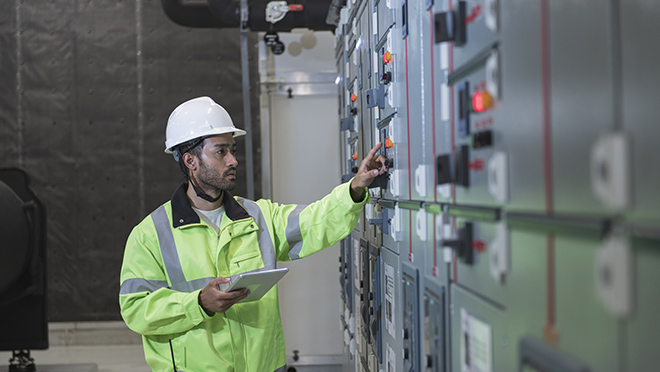 BC Hydro offers an integrated energy audit (IEA) and a feasibility study. What are the differences, and which one might be best for you?
BC Hydro offers an integrated energy audit (IEA) and a feasibility study. What are the differences, and which one might be best for you?
Evaluating the best way to save energy
If you're a regular reader of Current, you'll know that we're constantly developing smart ways to help our industrial and large commercial customers maximize the energy efficiency of their facilities to reduce energy usage in the short-term – and to reduce future loads on B.C.'s power grid in the long-term.
A lot of these projects begin with either an integrated energy audit (IEA) or a feasibility study (FS). They both involve an energy expert coming to your facility for an evaluation, but a lot of customers are confused about which one they need. So, we thought it might be useful to compare them side by side.
We asked Shantanav Bhowmick, a program manager for Conservation and Energy Management at BC Hydro to help distinguish them: "An integrated energy audit is best suited when the customer is unsure of the energy usage, breakdown and energy improvement opportunities at their existing facilities, and is interested in developing a priority list of such opportunities."
"On the other hand, a feasibility study is best suited when the scope of work is well understood, and a deeper investigation is needed to assess the feasibility, cost-benefit and financial justification of a particular energy improvement opportunity. A feasibility study focuses on a specific system or process, not the entire facility," says Shantanav.
Both options are available to industrial customers as well as large commercial customers. Commercial customers must have company-wide, annual electricity consumption of at least two gigawatt-hours (GWh). Let's look at each one individually.
Integrated energy audit (IEA)
When might you need one?
An integrated energy audit is for when you want a high-level understanding of potential ways to save energy around your facility, but don't know where to start.
What does it involve?
If you're an eligible customer, you can get integrated energy audit funding for a BC Hydro Alliance energy expert to conduct an energy audit of your facility. The integrated energy audit offers lots of flexibility and customization, focusing on opportunities in specific areas or end-uses, such as:
- Overall energy efficiency, including load displacement.
- Demand response.
- Efficient electrification.
The integrated energy audit can look at all opportunities for both large commercial and industrial sites. It's a one-stop, high-level check to make sure you're not leaving anything on the table. Next steps from an IEA are usually one of the following:
- Straightforward, low-cost opportunities go directly towards implementation. Customers can apply for our custom incentive for financial support for implementation.
- Complex, high-cost opportunities usually result in a feasibility study to investigate the opportunity in detail.
Feasibility study
When might you need one?
A feasibility study is for when you have a project idea with a defined scope in mind and you want to better understand the cost and energy impacts.
What does it involve?
If there's a system or equipment at your facility that you'd like to replace, optimize, or upgrade as an energy improvement opportunity, a feasibility study provides you with an in-depth analysis of the options, risks and cost-benefit. This may include:
- Upgrading inefficient systems to be more energy efficient.
- Becoming more self-reliant by generating your own power from renewable sources to displace some of the electricity you require from us.
- Reducing your facility's reliance on fossil fuel powered equipment.
- Taking advantage of demand response programs that reduce your energy costs.
Feasibility studies are customizable and can apply to one or multiple interrelated systems at your existing site, site expansion, or a new site you're developing. The results of the study will help you make a strategic decision to move forward with a project incentive application.
Energy opportunities arising from a feasibility study usually involve:
- Energy efficiency improvements: Optimizing energy use and reducing consumption. This also includes customer-based power generation that offsets your own energy use, such as load displacement.
- Efficient electrification: Switching from fossil fuels to clean electricity and reducing greenhouse gas (GHG) emissions.
- Demand response participation: Reducing your peak energy usage and lowering your demand charges.
What funding is available?
Funding for both IEAs and feasibility studies is subject to customer eligibility and an engineering review of the application. "IEA funding is capped at $50K. One application can bundle together up to 10 sites," says Shantanav. "For feasibility studies, bundling sites is not permitted. Instead, multiple interrelated energy opportunities can be studied together in a more integrated approach. Usually, if the potential energy improvement is 200 megawatt-hours (MWh) per year or more, BC Hydro will fully fund the study. If the potential energy improvement is lower than 200 MWh per year, BC Hydro will fund 50% of the study. Either way, the funding for a feasibility study is capped at $100K."
Want to know more?
To find out more about integrated energy audits (IEAs) or feasibility studies, contact your Key Account Manager or Regional Energy Manager, or call 604 522 4713 in the Lower Mainland or 1 866 522 4713 elsewhere in B.C.